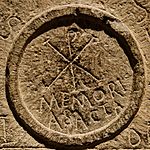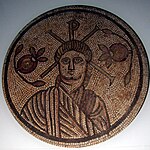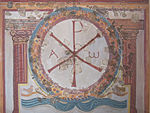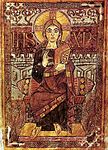Chi Rho

The Chi Rho (☧, English pronunciation /ˈkaɪ ˈroʊ/; also known as chrismon[1]) is one of the earliest forms of the Christogram, formed by superimposing the first two (capital) letters—chi and rho (ΧΡ)—of the Greek ΧΡΙΣΤΟΣ (rom: Christos) in such a way that the vertical stroke of the rho intersects the center of the chi.[2]
The Chi-Rho symbol was used by the
In pre-Christian times, the Chi-Rho symbol was also used to mark a particularly valuable or relevant passage in the margin of a page, abbreviating chrēston (good).[3] Some coins of Ptolemy III Euergetes (r. 246–222 BC) were marked with a Chi-Rho.[4]
Although formed of Greek characters, the device (or its separate parts) is frequently found serving as an abbreviation in Latin text, with endings added appropriate to a Latin noun, thus XPo, signifying Christo, "to Christ", the
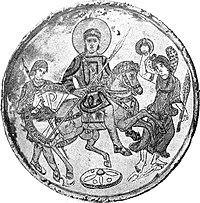
Origin and adoption
According to

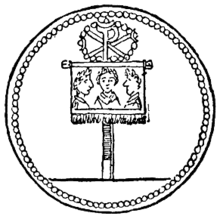

In a memoir of the Roman emperor that Eusebius wrote after Constantine's death (On the Life of Constantine, c. 337–339), a miraculous appearance is said to have come in
Eusebius wrote in the Vita that Constantine himself had told him this story "and confirmed it with oaths" late in life "when I was deemed worthy of his acquaintance and company." "Indeed", says Eusebius, "had anyone else told this story, it would not have been easy to accept it."
Eusebius also left a description of the labarum, the military standard which incorporated the Chi-Rho sign, used by Emperor Constantine in his later wars against Licinius.[8]
Later usage
Late antiquity
An early visual representation of the connection between the
After Constantine, the Chi-Rho became part of the official
In 2020, archaeologists discovered in Vindolanda in northern England a 5th-century chalice covered in religious iconography, including the Chi-Rho.[14][15]
Insular Gospel books
In
Famous examples are in the
In Unicode
The Chi Rho symbol has two
- U+2627 ☧ CHI RHO in the Miscellaneous symbols block and
- U+2CE9 ⳩ COPTIC SYMBOL KHI RO in the Coptic block.
Gallery
-
The Chi-Rho symbol ☧, Catacombs of San Callisto, Rome.
-
Monogramme of Christ (the Chi Rho) on a plaque of a sarcophagus, 4th-century AD, marble, Musei Vaticani, on display in a temporary exhibition at the Colosseum in Rome, Italy
-
The Chi-Rho symbol ☧, Catacombs of Domitilla, Rome.
-
The Chi-Rho symbol ☧ with Alpha and Omega, Catacombs of Domitilla, Rome.
-
XI monogram, c. 400.
-
The Chi-Rho with a wreath symbolizing the victory of the Resurrection, above Roman soldiers, c. 350.
-
Chi-Rho on a 4th-centuryaltar, Khirbet Um El’Amad, Algeria.
-
Roman Chi Rho applique in bronze from a Germanic settlement in Neerharen (Belgium), 375-450 AD, Gallo-Roman Museum (Tongeren)
-
Silver ring with Chi Rho symbol found at a Christian burial site in Late Roman Tongeren (Belgium), 4th century AD, Gallo-Roman Museum (Tongeren)
-
Christian pendant ofLouvre.
-
Roman Christian mosaic with Chi-Rho,Hinton St. Mary, England.
-
Reconstruction of Chi-Rho fresco from Roman villa at Lullingstone, including Alpha and Omega.
-
Sarcophagus with Chi-Rho symbol and Alpha and Omega, 6th century, Soissons, France
-
Folio 34r of theChrist.
-
Sequential "XPS" in the Carolingian Godescalc Evangelistary.
-
Chi-Rho on the roof of theBasilica of St. John Lateran, Rome.
-
Chi-Rho andaltar.
-
Chi-Rho onCincinnati, Ohio.
-
Chi-Rho and Alpha and Omega in the Main Cathedral of the Russian Armed Forces
-
Chi-Rho symbol can be seen on the coat of arms of Niš, city in Serbia and the birthplace of Constantine the Great
See also
- Alpha and Omega
- Chi Rho (disambiguation)
- Christian symbolism
- Christogram
- Ichthys
- Labarum
- Merchant's mark
- Kyrios
References
Notes
- Middle Latin crismon), specifically applied to the "Chrismon of Saint Ambrose" in Milan Cathedral. Crismon (par les Bénédictins de St. Maur, 1733–1736), in: du Cange, et al., Glossarium mediae et infimae latinitatis, ed. augm., Niort: L. Favre, 1883‑1887, t. 2, col. 621b. "CRISMON, Nota quæ in libro ex voluntate uniuscujusque ad aliquid notandum ponitur. Papias in MS. Bituric. Crismon vel Chrismon proprie est Monogramma Christi sic expressum ☧"; 1 chrismon (par les Bénédictins de St. Maur, 1733–1736), in: du Cange, et al., Glossarium mediae et infimae latinitatis, ed. augm., Niort : L. Favre, 1883‑1887, t. 2, col. 318c Archived 2016-08-26 at the Wayback Machine.
- ^ Steffler 2002, p. 66.
- ^ Southern 2001, p. 281; Grant 1998, p. 142, citing Bruun, Studies in Constantinian Numismatics.
- ^ von Reden 2007, p. 69: "The chi-rho series of Euergetes' reign had been the most extensive series of bronze coins ever minted, comprising eight denominations from 1 chalkous to 4 obols."
- Thomas de Camoys, 1st Baron Camoys (d.1421) in St George's Church, Trotton, Sussex, England
- ^ Lactantius. On the Deaths of the Persecutors, Chapter 44.
- ^ The well known sentence In hoc signo vinces is simply a later Latin translation of Eusebius's Greek wording.
- ^ Eusebius Pamphilius: Church History, Life of Constantine, Oration in Praise of Constantine, Chapter 31.
- ^ Kenelm Henry Digby, Mores Catholici, Or, Ages of Faith vol. 1 (1844), p. 300.
- ^ A. L. Millin, Voyage dans le Milanais (1817), p. 51.
- ^ Harries 2004, p. 8. Sarcophagus with Scenes of the Passion (probably from the Catacomb of Domitilla), Rome, mid-fourth century. Marble, 23ʺ x 80ʺ. Museo Pio Christiano, Vatican, Rome.
- ^ Kellner 1968, p. 57ff. See also Grigg 1977, p. 469 (Note #4).
- ^ Johns 1996, p. 67.
- ^ "Hadrian's Wall dig reveals oldest Christian graffiti on chalice". theguardian. 29 August 2020.
- ^ "Early Christian Chalice Unearthed in Northern England". archaeology.org. 31 August 2020.
- ^ In the Latin Vulgate the verse was "Christi autem generatio sic erat cum esset desponsata mater eius Maria Ioseph antequam convenirent inventa est in utero habens de Spiritu Sancto" ("Now the birth of Jesus Christ took place in this way. When his mother Mary had been betrothed to Joseph, before they came together she was found to be with child from the Holy Spirit")
- ^ Lewis 1980, pp. 142–143.
- ^ Lewis 1980, pp. 143–144.
- ^ Lewis 1980, p. 144.
- ^ Lewis 1980, p. 153.
Bibliography
- Grant, Michael (1998). The Emperor Constantine. London, United Kingdom: Phoenix Giant. ISBN 0-7538-0528-6.
- Grigg, Robert (December 1977). ""Symphōnian Aeidō tēs Basileias": An Image of Imperial Harmony on the Base of the Column of Arcadius". The Art Bulletin. 59 (4): 469–482. JSTOR 3049702.
- Harries, Richard (2004). The Passion in Art. Burlington, Vermont: Ashgate Publishing Company. ISBN 0-7546-5011-1.
- Johns, Catherine (1996). The Jewellery of Roman Britain: Celtic and classical Traditions. Oxon, United Kingdom: Routledge (Taylor & Francis Group). ISBN 1-85728-566-2.
- Kellner, Wendelin (1968). Libertas und Christogramm: Motivgeschichtliche Untersuchungen zur Münzprägung des Kaisers Magnentius (350-353) (in German). Karlsruhe, Germany: Verlag G. Braun.
- Lewis, Suzanne (1980). "Sacred Calligraphy: The Chi Rho Page in the Book of Kells". Traditio. 36. Cambridge University Press: 139–159. S2CID 151747754.
- Southern, Pat (2001). The Roman Empire from Severus to Constantine. New York, New York and London, United Kingdom: Routledge (Taylor & Francis Group). ISBN 0-415-23943-5.
- Steffler, Alva William (2002). Symbols of the Christian Faith. Grand Rapids, Michigan and Cambridge, United Kingdom: Wm. B. Eerdmans Publishing. ISBN 0-8028-4676-9.
- von Reden, Sitta (2007). Money in Ptolemaic Egypt: From the Macedonian Conquest to the End of the Third Century BC. Cambridge, United Kingdom: Cambridge University Press. ISBN 978-0-521-85264-7.
Further reading
- Heiland, Fritz (1948). "Die astronomische Deutung der Vision Kaiser Konstantins". Sondervortrag Im Zeiss-Planatarium-Jena: 11–19.
- Latura, George (2012). "Plato's Visible God: The Cosmic Soul Reflected in the Heavens". Religions. 3 (3): 880–886. .
- Rahner, Hugo (1971). Greek Myths and Christian Mystery. Translated by Battershaw, Brian. New York, New York: Biblo & Tannen Booksellers and Publishers Incorporated. ISBN 0-8196-0270-1.
External links
 Media related to Chi Rho at Wikimedia Commons
Media related to Chi Rho at Wikimedia Commons- "Constantine Triumphed under Sign of Cross". christianity.com.







